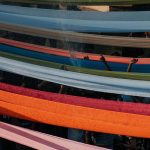Ever wondered if your polyester raincoat truly keeps you dry?
In 'Does Polyester Repel Water? A Fabric Analysis,' we delve into the science behind polyester's water-repelling abilities.
We'll explore the factors influencing water repellency, from fabric construction to chemical treatments.
By testing polyester's water resistance against other common fabrics, you'll gain a comprehensive understanding of its performance.
Discover the best practices for maintaining polyester's water repellency and how it translates to real-world scenarios.
Whether you're an outdoor enthusiast or a textile connoisseur, this analysis will equip you with the knowledge to make informed decisions about your polyester garments.
Key Takeaways
- The molecular structure of polyester, including its long-chain polymers, contributes to its hydrophobic nature and water-repellent abilities.
- Advanced fabric technology, including micro-sized gaps between fibers and chemical coatings or treatments, enhances polyester's water-repellent properties.
- Factors such as fabric composition, weave structure and density, and coating or treatment methods affect the water repellency of polyester.
- Environmental influences, such as exposure to sunlight, frequent washing with detergents, and contact with harsh chemicals, can impact and compromise polyester's water-repellent properties.
The Science of Polyester
When it comes to understanding the science of polyester, it's important to recognize how the molecular structure of this synthetic fabric affects its ability to repel water. Polyester science delves into the intricate arrangement of molecules within the fabric. The unique composition of polyester, with its long-chain polymers, contributes to its hydrophobic nature. This means that the molecular structure of polyester repels water, making it an excellent choice for outdoor and athletic wear.
Fabric technology has played a crucial role in enhancing the water-repelling properties of polyester. Through advanced manufacturing processes, polyester fabrics can be engineered to have micro-sized gaps between the fibers, further improving their ability to resist water penetration. Additionally, the application of chemical coatings or treatments during the production stages enhances the fabric's hydrophobic characteristics, making it even more effective in repelling water.
Understanding the science behind polyester and its advancements in fabric technology provides valuable insights for those seeking to master the intricacies of textile engineering. This knowledge empowers individuals to make informed decisions when selecting polyester-based products, ensuring that they meet specific performance requirements, especially in terms of water repellency.
Water Repellent Properties
To determine the water-repellent properties of polyester, you can conduct a simple water droplet test on the fabric surface. Place a small droplet of water on the polyester fabric and observe its behavior. If the water beads up and rolls off the surface without being absorbed, it indicates that the polyester fabric has water-repellent properties. This is due to the hydrophobic nature of polyester, which prevents water from permeating the fabric.
| Water Droplet Test | Result |
|---|---|
| Beads up and rolls off | Water-repellent |
| Spreads and gets absorbed | Not water-repellent |
Polyester's water-repellent properties are a result of advanced fabric technology, which has enhanced its application in outdoor activities. The sustainability aspect of polyester also contributes to its water-repellent properties, as it can endure various environmental conditions without degrading. This makes it an ideal choice for outdoor gear and apparel, providing protection against water during activities such as hiking, camping, or sports. The combination of fabric technology, sustainability, and practical application makes water-repellent polyester a valuable choice for outdoor enthusiasts.
Factors Affecting Water Repellency
When it comes to the water repellency of polyester and other fabrics, several factors come into play.
The composition of the fabric itself can impact its ability to repel water, as well as the methods used to treat its surface.
Additionally, environmental influences such as exposure to sunlight, dirt, and other elements can affect the fabric's water repellency.
Fabric Composition Impact
Fabric composition significantly affects the water repellency of polyester. The following factors impact the water repellency of polyester fabric:
- Fiber Type: The type of fibers used in the fabric greatly influences its water repellency. For example, hydrophobic fibers like polyester inherently repel water, while hydrophilic fibers like cotton tend to absorb moisture, reducing water repellency.
- Weave Structure: The weave pattern and density of the fabric significantly impact its water repellency. Tight weaves and densely packed fibers enhance the fabric's ability to repel water, whereas looser weaves may allow water to penetrate.
- Coating or Treatment: Some polyester fabrics are treated with water-repellent coatings or finishes to enhance their hydrophobic properties. These treatments create a barrier on the fabric's surface, preventing water from being absorbed.
Understanding these factors can help you choose polyester fabrics with optimal water repellency based on your specific needs.
Surface Treatment Methods
Enhancing the water repellency of polyester involves applying surface treatments that modify the fabric's properties. There are several methods for treating polyester to improve its water repellency, including applying chemicals, heat treatment, surface coating, and nanotechnology.
| Surface Treatment Methods | Description |
|---|---|
| Applying Chemicals | Involves treating the fabric with specific chemicals that alter its surface properties to repel water effectively. |
| Heat Treatment | Utilizes controlled heat to modify the polyester's structure, enhancing its ability to repel water. |
| Surface Coating | Involves applying a protective coating to the fabric's surface, creating a barrier that prevents water from permeating the material. |
| Nanotechnology | Utilizes nanomaterials to create a water-repellent layer on the fabric's surface, enhancing its hydrophobic properties. |
These methods play a crucial role in enhancing the water repellency of polyester, providing various options for manufacturers to choose from based on the specific requirements of their products.
Environmental Influences on Repellency
To maintain the water repellency of polyester, environmental factors such as exposure to sunlight and frequent washing can impact the fabric's ability to repel water effectively.
Environmental impact and sustainability concerns play a significant role in the water repellency of polyester. Here are three key factors to consider:
- Exposure to Sunlight: Prolonged exposure to sunlight can degrade the water-repellent coating on polyester fabric, reducing its effectiveness over time. Ultraviolet (UV) radiation can break down the chemical bonds in the coating, diminishing the fabric's ability to repel water.
- Frequent Washing: Regular washing can also compromise the water repellency of polyester. Detergents and fabric softeners can strip away the water-repellent finish, leading to decreased performance in repelling water.
- Chemical Exposure: Contact with harsh chemicals, such as chlorine in swimming pools or certain cleaning agents, can also diminish the fabric's water repellency, impacting its environmental sustainability.
Testing Polyester's Water Repellency
You can easily test polyester's water repellency at home using a simple water droplet test. This method is a quick way to assess the effectiveness of the water repellent treatment on polyester fabrics.
Start by placing a few drops of water on the fabric's surface. If the water beads up and rolls off the fabric, it indicates that the polyester is maintaining its water repellency. However, if the water is absorbed into the fabric or spreads out, it suggests that the water repellent treatment may have deteriorated and the fabric is no longer effectively repelling water.
Durability testing is also an important aspect of assessing polyester's water repellency. The fabric should be subjected to various conditions that mimic real-world usage, such as washing, exposure to sunlight, and abrasion. These tests help determine how well the water repellency holds up over time and with regular use.
Comparing Polyester to Other Fabrics
When comparing polyester to other fabrics in terms of water repellency, it's important to consider the differences in their composition and performance.
You'll find that certain fabrics may excel in repelling water in specific conditions, while others may offer better breathability.
Understanding how polyester stacks up against other materials will provide valuable insights into its suitability for various uses and environments.
Water Repellency Comparison
When assessing water repellency, polyester outperforms some fabrics but falls short compared to others.
- Fabric technology plays a crucial role in determining water repellency. Fabrics with advanced technology, such as Gore-Tex, are designed to repel water effectively.
- Waterproof textiles, like nylon and polyethylene, offer superior water repellency compared to polyester. These textiles are engineered to prevent water penetration, making them ideal for outdoor activities in wet conditions.
- Natural fibers, such as wool and cotton, are less water repellent than polyester. While they may offer some level of water resistance, they aren't as effective as polyester in repelling water.
Understanding the differences in water repellency among various fabrics can help you make informed decisions when choosing clothing for different outdoor activities.
Polyester Vs Other Fabrics
Comparing polyester to other fabrics in terms of water repellency reveals significant differences in performance.
Polyester is known for its durability and ability to retain its shape and resist wrinkles, making it a popular choice for outdoor and athletic wear.
However, when it comes to breathability, natural fabrics like cotton and wool tend to outperform polyester.
Cotton, for example, is highly breathable and can absorb a significant amount of water before feeling damp, while wool naturally repels water and provides excellent insulation even when wet.
When choosing a fabric for specific activities or weather conditions, it's important to consider both water repellency and breathability to ensure comfort and performance.
While polyester offers impressive durability, natural fabrics may provide better breathability in certain situations.
Maintaining Water Repellency
To maintain water repellency in polyester fabric, you should regularly reapply a durable water repellent (DWR) treatment. This treatment helps to ensure that water beads up and rolls off the fabric instead of being absorbed.
Here are three essential tips for maintaining water repellency in polyester:
- Clean Regularly: Dirt, oils, and other residues can clog the pores of the fabric, reducing its water repellency. Regularly washing your polyester garment with a gentle detergent can help maintain its water repellent properties.
- Avoid Fabric Softeners: Fabric softeners can leave a residue on the fabric, which can interfere with the DWR treatment. Instead, use a specialized detergent designed for technical fabrics to maintain the water repellency.
- Reapply DWR Treatment: Over time and with use, the DWR treatment on polyester fabric can wear off. To ensure continued water repellency, it's essential to reapply the DWR treatment as per the manufacturer's guidelines.
Real-world Performance
Maintaining water repellency in polyester fabric involves testing its performance in real-world conditions. Real-life testing is crucial to assess the practical application of water repellency in polyester fabric. In the real world, polyester garments are subjected to various environmental conditions such as rain, snow, and humidity. Understanding how polyester fabric performs in these conditions is essential for assessing its water repellency in practical situations.
Real-life testing involves subjecting polyester fabric to scenarios that mimic everyday use. This includes exposure to rain showers, water splashes, and wet environments. By observing how the fabric behaves in these situations, manufacturers and consumers can gauge its water repellent properties in practical application. Real-world performance testing also considers factors like durability, breathability, and comfort alongside water repellency. This comprehensive approach ensures that the fabric's water repellency is evaluated in a holistic manner.
Frequently Asked Questions
How Does the Production Process of Polyester Affect Its Water Repellent Properties?
The production process of polyester significantly influences its water repellent properties. The fabric composition, including the type of fibers and treatment during manufacturing, plays a crucial role in determining the level of water resistance.
Are There Any Environmental Concerns Related to the Water Repellency of Polyester?
When it comes to the water repellency of polyester, you should consider the environmental impact. While polyester may repel water effectively, it's important to explore sustainable alternatives to minimize ecological concerns associated with its production and use.
Can Polyester Lose Its Water Repellency Over Time, and if So, How Can It Be Restored?
Over time, polyester may lose its water repellency due to wear and tear. To restore it, consider using special detergents or sprays designed for polyester fabrics. Regular maintenance can help maintain polyester's durability and water repellency.
Are There Any Specific Industries or Applications Where Water Repellent Polyester Is Commonly Used?
Waterproof textiles are widely used in outdoor gear for their water repellency. The fashion industry and medical textiles also benefit from water repellent polyester due to its durability and protective qualities, making it a versatile material.
What Are the Potential Health and Safety Implications of Using Water Repellent Polyester in Clothing or Other Products?
When using water-repellent polyester in clothing or products, it's crucial to be aware of potential health implications and safety concerns. Proper ventilation and handling practices can mitigate risks associated with this material.
- How Does Ring Spun Cotton Affect Garment Fit and Shape Retention? - August 13, 2024
- What Are the Challenges in Producing Ring Spun Cotton? - August 13, 2024
- Is Ring Spun Cotton Suitable for Plus-Size Clothing? - August 13, 2024







